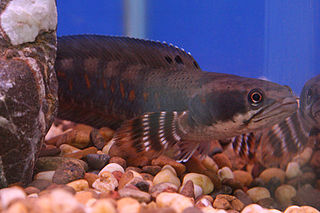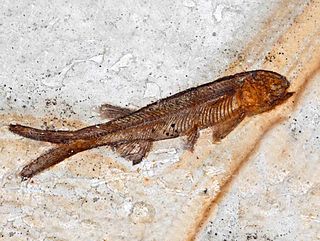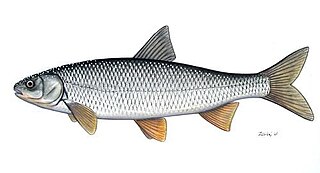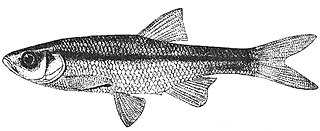 W
WFreshwater fish are those that spend some or all of their lives in fresh water, such as rivers and lakes, with a salinity of less than 1.05%. These environments differ from marine conditions in many ways, the most obvious being the difference in levels of salinity. To survive fresh water, the fish need a range of physiological adaptations.
 W
WCavefish or cave fish is a generic term for fresh and brackish water fish adapted to life in caves and other underground habitats. Related terms are subterranean fish, troglomorphic fish, troglobitic fish, stygobitic fish, phreatic fish and hypogean fish.
 W
WAokiichthys is an extinct genus of basal osteoglossoid from an Early Cretaceous freshwater palaeolake of what is now Kyushu, Japan. The genus formed a species radiation in the First Formation within the Wakino Subgroup of the Kwanmon Group, as a dominant member and namesake of the Nipponamia-Aokiichthys fauna. The genus became extinct at the end of either the 1st Formation, or possibly during the 2nd Formation, when the palaeolake became shallower.
 W
WArchaeomaenidae is an extinct family of pachycormid fish found in freshwater environments of Jurassic New South Wales of Australia, China, and Antarctica, and in Lower Cretaceous New South Wales and Mongolia.
 W
WThe Buenos Aires tetra is a tropical fish from South America. It was first observed in the wild in 1907, by Carl H. Eigenmann.
 W
WChanna pulchra is a species of snakehead fish in the family Channidae which is native to Myanmar. It was first described in 2007 by R. Britz from a specimen collected from the Kyeintali Chaung (stream) basin in Rakhine Yoma, western Myanmar. The fish is found in streams that are fast flowing, clear, highly oxygenated and relatively cold (subtropical). It is of little food value but getting popularity as an aquarium fish recently.
 W
WCottus microstomus is a species of sculpin, a European freshwater fish in the family Cottidae. It is widespread in the Dniester drainage, Odra and Vistula drainages, most likely extending further east to the Gulf of Finland. It is part of the wider European Cottus gobio complex, and possibly makes hybrid zones with Cottus gobio and Cottus koshewnikowi. It is a demersal fish, up to 10.1 cm long.
 W
WDiplomystus is an extinct genus of freshwater clupeomorph fish distantly related to modern-day extant herrings, alewives, and sardines. The genus was first named and described by Edward Drinker Cope in 1877. There are seven species of Diplomystus: D. dentatus, D. birdii, D. dubetreiti, D. shengliensis, D. kokuraensis, D. primotinus, and D. altiformis.
 W
WHippichthys heptagonus, the belly pipefish, is a species of freshwater pipefish of the family Syngnathidae. It is found from Kenya and South Africa to the Solomon Islands, and from southern Japan to New South Wales. It is a demersal species, living in the lower parts of rivers and streams, estuary habitats such as mangroves and tidal creeks, and occasionally in large lakes. It feeds on small crustaceans, such as copepods and cladocerans, as well as dipteran and ephemopteran larvae. It can grow to lengths of 15 centimetres (5.9 in). This species is ovoviviparous, with females depositing eggs on the males, who in turn give birth to live young several weeks later. Males may brood at 6.5–7.5 centimetres (2.6–3.0 in).
 W
WThe beady pipefish is a species of pipefish of the family Syngnathidae. It is found in the Indo-West Pacific, from the western Persian Gulf, to the north central Indian Ocean, to Japan and Australia. It lives in the lower parts of streams and rivers, estuarine habitats such as seagrass beds and mangroves, and shallow inshore habitats, where it can grow to lengths of 16–18 centimetres (6.3–7.1 in). It is expected to feed on small crustaceans, similar to other pipefish. This species is ovoviviparous, with males carrying eggs in a brood pouch before giving birth to live young. Average brood size is 177.
 W
WLycopteridae is an extinct family of freshwater osteoglossomorph ray-finned fishes.
 W
WMadariscus robustus is an extinct prehistoric freshwater ray-finned fish, of the family Archaeomaenidae, that lived during the Jurassic period on Australia. Its fossils, originally described as "Archaeomaene robustus," have been found on the Colalura Sandstone.
 W
WPhareodus is a genus of freshwater fish from the Paleocene to the Eocene of Australia, Europe and North and South America.
 W
WRutilus frisii, called the vyrezub, Black Sea roach, or kutum, is a species of fish in the family Cyprinidae, native to the basins of the Black Sea, Sea of Azov, and Sea of Marmara from the rivers of Bulgaria to western Transcaucasia and in Lake Iznik (Turkey).
 W
WThe Tashkent riffle bleak is a fish species of family Cyprinidae. Widespread in the Central Asia in Syr-Darya basin. Benthopelagic temperate freshwater fish, up to 14.2 cm in length.